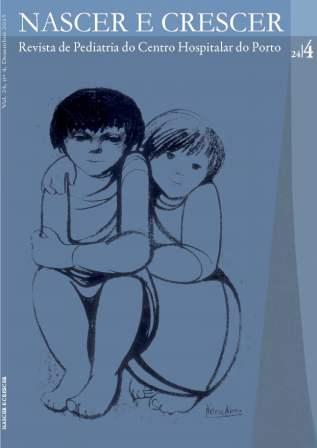Pediatric renal transplantation: a single center experience
DOI:
https://doi.org/10.25753/BirthGrowthMJ.v24.i4.8476Keywords:
pediatric renal transplantation, end-stage renal disease, graft survivalAbstract
Introduction: End-stage renal disease in children is associated with numerous comorbidities and with age-specific mortality rates approximately 30 times higher than in healthy children. The first kidney transplantation in children was performed successfully in 1954. Surgical advances and new immunosuppressive medications have greatly improved patient’s and graft’s survival in the last years.
Aim: Report Centro Hospitalar do Porto experience in pediatric renal transplantation in the last 30 years.
Methods: Epidemiological and clinical data of all patients younger than 18 years, transplanted between January 1984 and August 2013, were collected from our database. In order to analyze the transplantation outcome in our center we compare graft survival between decades (1984-89 / 1990-99 / 2000-09 / 2010-13). We also compare graft survival between two age groups of patients (0-10 years ; 11-17 years) at the time of surgery.
Results: One hundred thirty-nine patients (58.3% male) underwent 147 renal transplants (6.8% live donors). Congenital anomalies of the kidney and urinary tract (56.5%) and glomerulonephritis (18.4%) were the major causes of renal disease. Uncensored graft survivals rates at 5, 10, 15 and 20 years were 84.7%, 71.1%, 60.0% and 51.0%, while patient survivals were 97.9%, 95.9%, 94.7% and 94.7% respectively. Graft survival improved over time and the difference between the decades was statistically significant (p=0.004). Despite the better survival in the group of patients older than 11 years, graft’s survival difference between the two age groups was not statistically significant (p=0.697).
Conclusion: The results of our hospital are comparable to other international centers. Significant improvement in survival was observed over the time. It seems that an accurate follow-up of our patients helps to minimize the negative impact of adolescence on graft survival rates.
Downloads
References
Massengill SF, Ferris M. Chronic kidney disease in children and adolescents. Pediatr Rev 2014; 35(1):16-29.
Dharnidharka VR, Fiorina P, Harmon WE. Kidney transplantation in children. N Engl J Med 2014; 371 (6):549-58.
Horslen S, Barr ML, Christensen LL, Ettenger R, Magee JC. Pediatric transplantation in the United States, 1996-2005. Am J Transplant 2007; 7:1339-58.
Schurman S, McEnery P. Factors influencing short-term and long-term pediatric renal transplantation survival. J Pediatr 1997; 130:455-6.
Roussey-Kesler G, Decramer S. Résultats de la transplantation rénale pédiatrique en France. Néphrologie & Thérapeutique 2011; 7:611-7.
Cochat P, Offner G. European best practices guidelines for renal transplantation (Part 2): Pediatrics (specific problems). Nephrol Dial Transplant 2002; 17:55-8.
Solez K, Colvin RB, Racusen LC et al. Banff 07 classification of renal allograft pathology: updates and future directions. Am J Transplant 2008; 8:753-60.
Branco F, Almeida F, Cavadas V, et al. Pediatric kidney transplantation: a single center experience with 134 procedures. Transplantation Proceedings 2013; 45:1057-9.
Gjertson DW, Cecka JM. Determinants of long-term survival of pediatric kidney grafts reported to the United Network for Organ Sharing kidney transplant registry. Pediatr Transplant 2001; 5:5-15.
Dharnidharka VR, Agodoa LY, Abbott KC. Effects of urinary tract infection on outcomes after renal transplantation in children. Clin J Am Soc Nephrol 2007; 2:100-6.
Macário F. Registo Português de transplantação renal 1980- 2014 – Gabinete de Registo da Sociedade Portuguesa de Nefrologia. Acessível em: http://www.spnefro.pt.
Afonso C, Mota C, Almeida M, Castro I. Registo Português de IRC Pediátrica em Tratamento de Substituição Renal (TSFR) 2013. Acessível em: www.spp.pt.
Registry of the European Society for Paediatric Nephrology and the European Renal Association and European Dialysis and Transplantation Association - ESPN/ERA-EDTA Annual report for 2012. Acessível em: http://www.espn-reg.org/ index.jsp?p=pua
Chesnaye N, Bonthuis M, Schaefer F, et al. Demographics of paediatric renal replacement therapy in Europe: a report of the ESPN/ERA-EDTA registry. Pediatr Nephrol 2014; 29 (12): 2403-10.
Smith JM, Martz K, Blydt-Hansen TD. Pediatric kidney transplant practice patterns and outcome benchmarks, 1987-2010: a report of the North American Pediatric Renal Trials and Collaborative Studies. Pediatr Transplant 2013; 17 (2):149-57.
Moudgil A, Dharnidharka VR, Lamb KE, Meier-Kriesche HU. Best allograft survival from Share-35 kidney donors occurs in middle-aged adults and young children – na analysis of OPTN data. Transplantation 2013; 95:319-25.
Gallinat A, Sotiropoulos GC, Witzke O, et al. Kidney grafts from donors ≤ 5yr of age: single kidney transplantation for pediatric recipients or en bloc transplantation for adults? Pediatr Transplant 2013; 17:179-84.
Sharma A, Fisher RA, Cotterell AH, King AL, Maluf DG, Posner MP. En bloc kidney transplantation from pediatric donors: comparable outcomes with living donor kidney transplantation. Transplantation 2011; 92:564-9.
Artigo 10 do Capítulo III da Lei 22/2007. Acessível em: página 4149 do Diário da República 1ª série – Nº 124 – 29 de Junho de 2007.
Lei 66/2007 (2ª série). Acessível em: Diário da República 2ª aérie – Nº 66 – 3 de Abril de 2007.
Cleper R, Bem Shalom E, Landau D, et al. Post-transplantation lymphoproliferative disorder in pediatric kidney-transplant recipients – a national study. Pediatr Transplantation 2012; 16: 619-26.
Bell LE, Bartosh SM, Davis CL, et al. Adolescent transition to adult care in solid organ transplantation: a consensus conference report. Am J Transplant 2008; 8:2230-427
Downloads
Published
How to Cite
Issue
Section
License
Copyright and Authors' Rights
All articles published in Nascer e Crescer - Birth and Growth Medical Journal are Open Access and comply with the requirements of funding agencies or academic institutions. For use by third parties, Nascer e Crescer - Birth and Growth Medical Journal adheres to the terms of the Creative Commons License "Attribution - Non-Commercial Use (CC-BY-NC)".
It is the author's responsibility to obtain permission to reproduce figures, tables, etc. from other publications.
Authors must submit a Conflict of Interest statement and an Authorship Form with the submission of the article. An e-mail will be sent to the corresponding author confirming receipt of the manuscript.
Authors are permitted to make their articles available in repositories at their home institutions, provided that they always indicate where the articles were published and adhere to the terms of the Creative Commons license.


